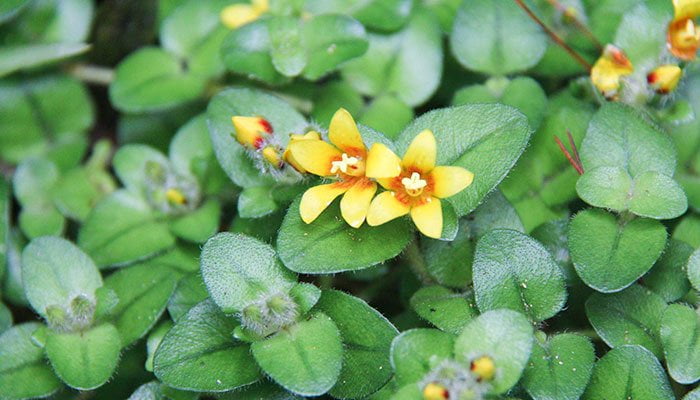What Is Jin Qian Cao
Jin Qian Cao commonly known as Herba Lysimachiae or Gold Coin Grass is the dried whole part of Lysimachia christinae Hance, which is a mat-forming perennial herb belonging to the family Primulaceae. It is a relatively practical and common Chinese herbal medicine, which first appeared in <Ben Cao Gang Mu Shi Yi> (a supplement to the compendium of materia medica) in the 30th year of Qianlong in the Qing Dynasty (1,765 AD).
There are about 266 species of Lysimachia, which are mainly distributed in the subtropical and temperate regions of the northern hemisphere. Among them, some species are used as commercial garden plants.
Lysimachia christinae commonly known as Christina loosestrife is endemic to China. They are distributed extensively in south, southwest, and central China with a subtropical continental monsoon climate.
This plant prefers warm, cool, and moist environments. They grow well in fertile, loose, sandy loams with a lot of humus. They often grow at altitudes below 3200 in ditch sides, shady roadsides, and forest understories.

In the summer and autumn, people gather the whole part of Lysimachia christinae Hance, remove impurities, dry them in the sun, cut them into sections, and make them into Chinese herbal medicines.
Jin Qian Cao contains kaempferol, quercetin, quercetin-3-o-glucoside, kaempferol-3-o-galattoside, kaempferol-3-o-triglycoside, 3,2′, 4’6-tetrahydroxy-4,3′-dimethoxychalcone, kaempferol-3-glucoside, kaempferol-3-rhamnoside-7-rhamanopyranosyl (1→3) rhamnoside, kaempferol-3-rutinoside, lysimachiin, isorhamnetin, hyperoside, isorhamnetin-3-o-β-D-robinoside, kaempferol-3-o-β-D-robinoside, rutin, tannin, volatile oils, amino acids, choline, sterols, potassium chloride, sodium chloride and nitrates.
Generally, the Jin Qian Cao with a slight odor and many leaves is preferred.
According to the Chinese Pharmacopoeia, the medicinal nature of Jin Qian Cao is slightly cold, with a sweet and salty taste. It has a certain therapeutic effect on the pathological changes of the liver, gallbladder, kidney, and bladder meridians.
In traditional Chinese medicine, it is often used to drain dampness to relieve jaundice, induce diuresis and relieve stranguria, remove toxins and reduce swelling, and treat jaundice due to damp-heat, gallbladder disorder with hypochondriac distending pain, difficulty and pain in micturition, brownish urine, nephritis edema, icteric hepatitis, virus hepatitis, chronic cholecystitis, chronic prostatitis, postoperative urinary retention, hydronephrosis, hepatobiliary lithiasis, urinary calculi, urinary tract infection, gout, hyperuricemia, carbuncle, and insect and snake bites.
There are more than 200 kinds of traditional Chinese medicine prescriptions containing it, such as Fu Fang Jin Qian Cao Granules, Gan Kang Granules, and Dan Shi Tong Li Capsules.
Benefits
- Anti-inflammation, inhibiting the production of inflammatory mediators in LPS-stimulated RAW 264.7 macrophages [1].
- Anti-oxidation, scavenging DPPH free radicals, ABTS free radicals, superoxide anion free radicals, and hydroxyl free radicals [2].
- Promoting bile secretion and emptying and improving lithocholic acid-induced cholecystitis in guinea pigs [3].
- Reducing LPS/D-Galactosamine, alcohol, or tripterygium glycosides-induced acute liver injury in mice and protecting the liver [1, 4, 5].
- Clearing heat and promoting diuresis, and treating jaundice due to damp-heat.
- Clearing damp-heat in the liver and gallbladder, and treating hepatobiliary lithiasis, and gallbladder disorder with hypochondriac distending pain.
- Inducing diuresis and treating difficulty and pain in micturition, and stranguria due to urolithiasis or heat.
- Removing toxins and reducing swelling, and treating carbuncle, pyogenic infection, and snake bites.
- It has a certain inhibitory effect on the humoral immunity and cellular immunity of mice. Also, it can enhance the phagocytosis of mouse neutrophils and macrophages.
- Its aqueous extract can reduce the cholesterol content in the bile of lithogenic model mice and inhibit the tendency of gallstone formation [6].
- Its water extract inhibited bone loss by suppressing osteoclastic bone resorption in OVX mice and osteoclast differentiation in vitro by suppressing RANK signaling pathways inducing osteoclastogenic transcription factors. In addition, WELC suppressed ovariectomy-induced body weight gain and fat accumulation in adipose and non-adipose tissues. It has anti-osteoporotic and anti-osteoclastogenic effects [7].
- Its methanolic extract may remarkably decelerate the neurodegeneration by minimizing neuronal cell damage via oxidative stress [8].
- Its total flavonoids can increase the urine volume of rats with experimental calcium oxalate stone, reduce calcium and oxalic acid concentrations in urine, and thus inhibit CaOx stone formation [9].
- Its extract effectively showed anticancer effects by inhibiting cancer cell proliferation and inducing apoptosis in estrogen receptor (ER)‐positive MCF‐7 and ER‐negative HCC38 human breast cancer cells. Moreover, its extract negatively regulated epithelial–mesenchymal transition (EMT) and decreased breast cancer cell migration in a range that does not cause cytotoxicity [10].
Combinations
- It can be used in combination with Yin Chen (Herba Artemisiae Scopariae), Zhi Zi (Fructus Gardeniae), Hu Zhang (Polygoni Cuspidati Rhizoma et Radix), etc to treat jaundice due to damp-heat.
- It can be used in combination with Yin Chen (Herba Artemisiae Scopariae), Da Huang (Radix et Rhizoma Rhei), Yu Jin (Turmeric Tuber), etc. to treat hepatobiliary lithiasis, and gallbladder disorder with hypochondriac distending pain caused by damp-heat in the liver and gallbladder.
- It can be used in combination with Hai Jin Sha (Spora Lygodii), Ji Nei Jin (Endothelium Corneum Gigeriae Galli), Hua Shi (Talcum), etc. to treat stranguria due to urolithiasis.
- It can be used in combination with Che Qian Zi (Semen Plantaginis), Bian Xu (Polygoni Avicularis Herba), etc. to treat stranguria due to heat.
- It can be used in combination with Pu Gong Ying (Dandelion), Ye Ju Hua (Wild Chrysanthemum Flower), etc. to treat carbuncle and pyogenic infection.
Side Effects
- At present, there is no literature report that Jin Qian Cao has toxic effects.
- Clinical reports show that it causes contact dermatitis and allergic reactions.
Precautions and Warnings
- The dosage of Jin Qian Cao should be controlled at 15-60g.
- It can be made into decoctions, pills, capsules, or mashed for external use.
- People who are allergic to Jin Qian Cao should not take it.
- Patients with diarrhea due to spleen deficiency should not take it.
- Pregnant and breastfeeding women should take it under medical supervision.
- Children, the elderly, and the infirm should take it under medical supervision.
